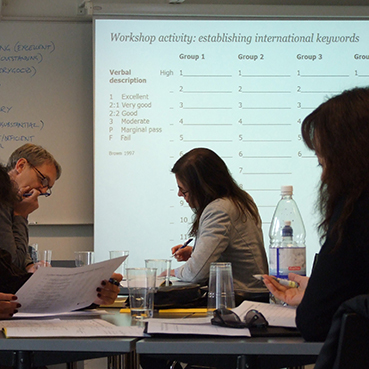Testing keywords internationally to define and apply undergraduate assessment standards in art and design
DOI:
https://doi.org/10.7577/formakademisk.1407Emneord (Nøkkelord):
assessment standards, internationalisation, art and design, keywordsSammendrag
What language should be featured in assessment standards for international students? Have universities adjusted their assessment methods sufficiently to match the increased demand for studying abroad? How might art and design benefit from a more stable definition of standards? These are some questions this paper seeks to address by reporting the results of recent pedagogic research at the School of the Arts, Loughborough University, in the United Kingdom. Language use is at the heart of this issue, yet it is generally overlooked as an essential tool that links assessment, feedback and action planning for international students. The paper reveals existing and new data that builds on research since 2009, aimed at improving students’ assessment literacy. Recommendations are offered to stimulate local and global discussion about keyword use for defining undergraduate assessment standards in art and design.
Nedlastinger
Publisert
2015-07-13
Hvordan referere
Harland, R. (2015). Testing keywords internationally to define and apply undergraduate assessment standards in art and design. FormAkademisk, 8(1). https://doi.org/10.7577/formakademisk.1407
Utgave
Seksjon
Artikler
Lisens
- Forfatteren(e) beholder sin opphavs- og kopieringsrett til eget manuskript, men gir tidsskriftet varig rett til 1) å fremføre manuskriptet for offentligheten i den opprinnelig publiserte digitale form, og 2) å registreres og siteres som første publisering av manuskriptet.
- Forfatteren må selv forvalte sine økonomiske kopieringsrettigheter overfor eventuell tredjepart.
- Tidsskriftet gir ingen økonomisk eller annen kompensasjon for innsendte bidrag, medmindre det er gjort særskilt avtale om dette med forfatteren(e).
- Tidsskriftet plikter å arkivere manuskriptet (inklusive metadata) i den opprinnelig publiserte digitale form, i minst ett dertil egnet åpent tilgjengelig langtidsarkiv for digitalt materiell, som for eksempel i de norske universitetenes institusjonsarkiv innen rammen av NORA-samarbeidet.
Verket vil bli publisert OpenAccess med en Creative Commons 4.0-lisens som tillater alle å lese, dele og tilpasse innholdet, også kommersielt, under lisensvilkårene:
Dette verket må tilskrives/ krediteres på riktig måte, en lenke må gis til CC-BY 4.0-lisensen, og endringer som er gjort må angis på en rimelig måte, men ikke på noen måte som antyder at lisensgiveren støtter deg eller din bruk.



